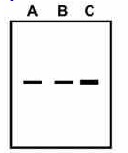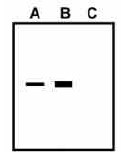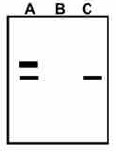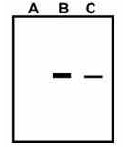Performance Meter
0%
QUESTION ID:1
A researcher observed ants in contact with plant hoppers that were feeding on tree sap. Which of the following conclusions made by her would be correct?
QUESTION ID:2
QUESTION ID:3
The table below summarizes the key signaling pathways that orchestrate development, their receptors, transcription effectors and output.
SIGNALING PATHWAY | RECEPTOR | TRANSCRIPTIONAL EFFECTOR | OUTPUT |
A. Wnt | Thick veins | β-catenin | Patterning |
B. Hedgehog | Frizzled | Ci/Gli | Growth |
C. RTK | EGFR | Pointed/Yan | Morphogenesis |
D. TGFβ | Patched | NICD | Cell Fate Specification |
E. JNK | TNF | Jun/Fos | Migration |
Which of the above pathways is correctly depicted in one of the options given below?
QUESTION ID:4
QUESTION ID:5
QUESTION ID:6
QUESTION ID:7
QUESTION ID:8
QUESTION ID:9
QUESTION ID:10
QUESTION ID:11
QUESTION ID:12
QUESTION ID:13
Consider the cancer types in Column P and the cancer related descriptions (Column Q)
Column P | Column Q | |
A. Leukemia | (i) | A tumor that has arisen from endodermal tissue |
B. Sarcoma | (ii) | Hematopoietic cell cancer that does not grow as a solid tumor |
C. Carcinoma | (iii) | A tumor that develops from mesodermal connective tissue |
D. Melanoma | (iv) | Cancer that develops from the pigment-producing cells of skin |
Select the option that represent all the correct matches
QUESTION ID:14
Column I | Column II | |
A. Cofilin | i | binds ADP-G-actin and catalyzes the exchange of ADP for ATP |
B. Profilin | ii | binds preferentially to filament containing ADP-actin |
C. Thymosin | iii | assembles unbranched filament |
D. Formin | iv | binds to ATP-G-actin and inhibits addition of actin subunit to filament |
QUESTION ID:15
QUESTION ID:16
QUESTION ID:17
Ecosystem | Global Area (106 Km2) | Mean Net Primary Productivity (NPP) per unit area (gm/m2/yr) | Mean biomass per unit area (kg/m2) |
Tropical rainforest | 17 | 2000 | 44 |
Swamp and marsh | 2 | 2500 | 15 |
Cultivated land | 14 | 644 | 1.1 |
Open ocean | 332 | 127 | 0.003 |
QUESTION ID:18
QUESTION ID:19
Iron deficiency is a common problem in humans worldwide. The homeostasis of iron in the body is maintained using various proteins (column- X) and their function (column- Y):
Column- X | Column- Y | |
A. Ferritin | i. | Hypoxia is known to reduce its synthesis |
B. Ferroportin | ii. | Plasma iron binding protein |
C. Transferrin | iii. | Intramucosal cell iron binding protein |
D. Hepcidin | iv. | Iron leaves mucosal cells through it |
QUESTION ID:20
Column X | Column Y | |
A. LTR retrotransposons | (i) | 7-21 bp target sequence |
B. Non-LTR retroposons | (ii) | copia elements |
C. SINEs | (iii) | Alu elements |
(iv) | L1 |
QUESTION ID:21
Fertilization between two mating types (P1 and P2) of Neurospora. led to a diploid ascus which gave rise to ascus containing 8 haploid ascospores. A set of DNA markers representing two linked loci was analyzed in P1. P2 and the °clads labeled 01 to 08 arranged from the tip to the base of the ascus. The observed profile is represented below
Which one of the following Is a correct conclusion of the above observation?
QUESTION ID:22
The table below lists terms used in bioremediation (column X) and explanations for the terms (column Y).
Column X | Column Y | |
(A) Bioventing | (i) | Indigenous level of containment degradation without any treatment |
(B) Natural attenuation | (ii) | It is a technique of adding oxygen to the saturated zone below water table to stimulate degradation |
(C) Air spraying | (iii) | It is a technique to add oxygen directly to a site of contamination in an unsaturated zone which stimulates in situ aerobic degradation |
(D) Biostimulation | (iv) | Modification of environmental conditions by adding nutrients to enhance biodegradation process |
Which one of the following options is a correct match between terms in column X and explanations in column Y?
QUESTION ID:23




QUESTION ID:24
Match the Indian Biosphere reserves (Column P) with the key fauna (Column Q) they are intended to protect.
Column P (Biosphere Reserve) | Column Q (Key fauna) | |
A. Gulf of Mannar | (i) | Musk deer |
B. Dihang-Dibang | (ii) | Saltwater crocodile |
C. Great Nicobar | (iii) | Dugong |
D. Seshachalam Hills | (iv) | Lion-tailed macaque |
E. Nilgiri Biosphere Reserve | (v) | Slender loris |
Which one of the following options has all correct matches between column P and Q?
QUESTION ID:25
QUESTION ID:26
QUESTION ID:27
QUESTION ID:28
The regions of phi, psi space occupied by well characterized protein secondary structures are marked on a Ramachandran plot as shown above. Which of the following statements is CORRECT?
QUESTION ID:29
QUESTION ID:30
QUESTION ID:31
QUESTION ID:32
QUESTION ID:33
To ensure proper segregation of chromosomes during mitosis, the sister chromatid pairs must be stably bi-oriented on the mitotic spindle. In animal cells, after nuclear envelope break down (NEBD), chromosomes glide along the microtubules' length with the help oft he motor proteins. When the chromosomes reach the plus-end of microtubules, thekinetochores attach to the microtubules. Which one of the following is the correct option for the kinetochore-microtubules attachment configuration that ensures preprohormone some segregation?
QUESTION ID:34
QUESTION ID:35
QUESTION ID:36
In the cladograms given below each nucleotide change is indicated by a black bar
Which one of the following options represents two equally most parsimonious trees?
QUESTION ID:37
Consider the defects in human macrophage cell lines (antigen presenting cells, Column A)and their possible consequence on T cell activation (Column B).
Column A | Column B | |
A. β2-microglobulin knockout macrophages | i | Cannot activate CD4+ or CD8+ T cells |
B. TLR4 knockout macrophages | ii | Cannot activate CD4+ T cells |
C. Macrophages with HLA region for DP, DQ and DR deleted | iii | Cannot activate CD8+ T cells |
D. B7 knockout macrophages | iv | Can activate CD4+ or CD8+ T cells |
Select the option that represents all the correct matches
QUESTION ID:38
QUESTION ID:39
 TLS Online
TLS Online